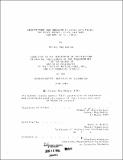Architecture and urbanism in Henri IV's Paris : the Place Royale, Place Dauphine, and Hôpital St. Louis
Author(s)
Ballon, Hilary Meg
DownloadFull printable version (30.60Mb)
Alternative title
Henri IV's Paris, Architecture and urbanism in
Other Contributors
Massachusetts Institute of Technology. Dept. of Architecture.
Advisor
Henry A. Millon.
Terms of use
Metadata
Show full item recordAbstract
This dissertation concerns the extensive building program which Henri IV undertook in Paris from 1600 to 1610. Focusing on the place Royale (now called the place des Vosges) , the place Dauphine, rue Dauphine, and Pont Neuf, and the hôpital St. Louis, this study holds that Henri IV's urbanism was guided by an emerging view of the city as a unified entity. Drawing from newly uncovered notarial documents, the dissertation examines the form and the function of the monuments and argues that each building was embedded in its physical context, engaged in the life of the city, and informed by an underlying urban vision . First, the buildings were not autonomous geometric forms dropped into open spaces; they were conceived as parts of a larger urban composition, structured by axes which linked the monuments to major roads without however diminishing the quality of spatial enclosure which the designs also promoted. Second, the squares and the hospital were each charged with a program anchored in the commercial, social, and sanitary life of the city. The place Royale and place Dauphine were planned as residential and commercial squares to stimulate trade and manufacturing while the hôpital St. Louis was intended to minimize the convulsive effect of the plague on the city. Finally, the dissertation argues that the royal building program was not merely a sequence of unrelated improvements and isolated adornments, but rather a series of coordinated efforts to impose a unifying order on the city. The monuments were assigned functions which addressed the city as a whole . They were physically linked to more distant parts of the city, and they were composed to create grand urban vistas. The urban fabric was no long e r conceived as an accumulation of fragments contained within the walls; it was understood as a cohesive network with its own internal order.
Description
Thesis (Ph. D.)--Massachusetts Institute of Technology, Dept. of Architecture, 1985. MICROFICHE COPY AVAILABLE IN ARCHIVES AND ROTCH. Includes bibliographical references (v. 2, leaves 348-379).
Date issued
1985Department
Massachusetts Institute of Technology. Department of ArchitecturePublisher
Massachusetts Institute of Technology
Keywords
Architecture.